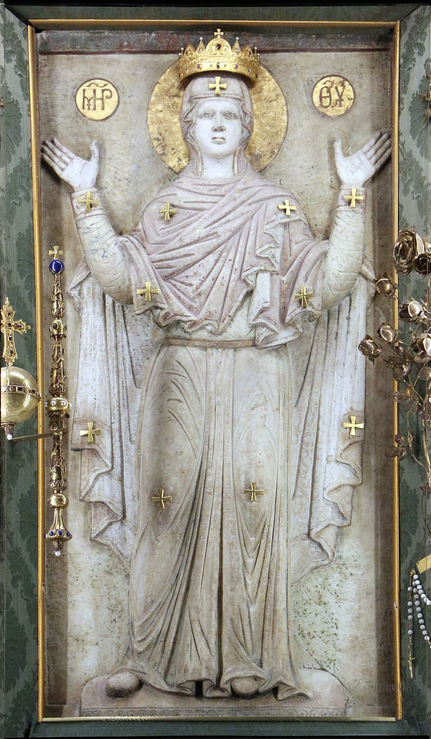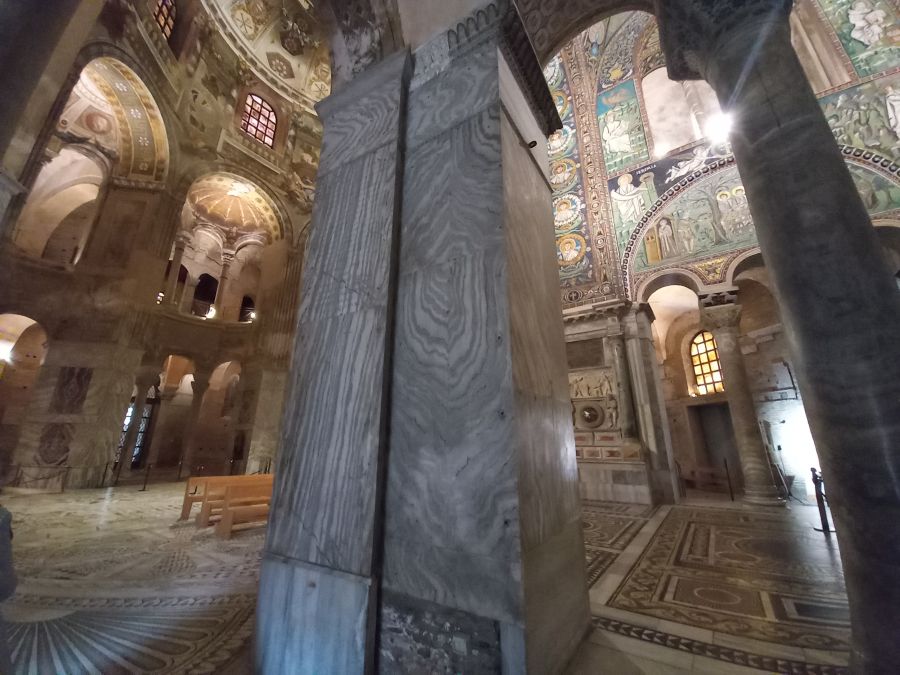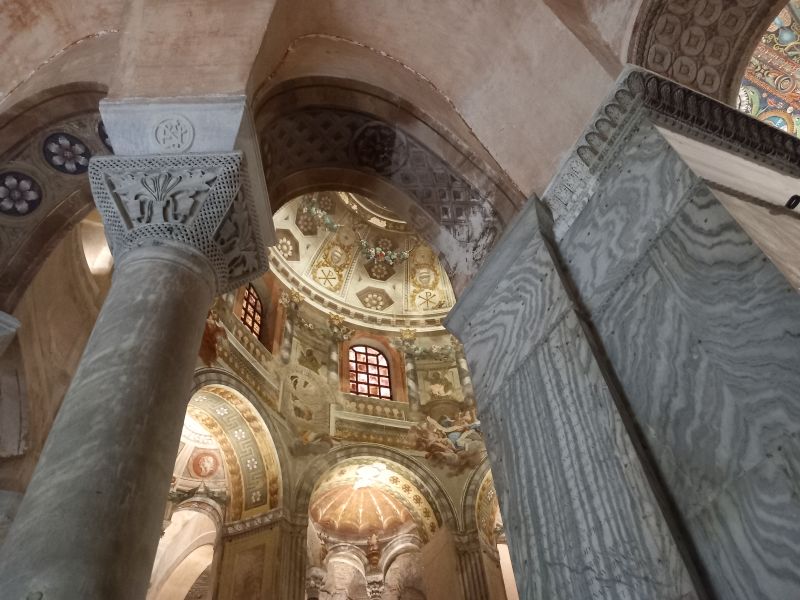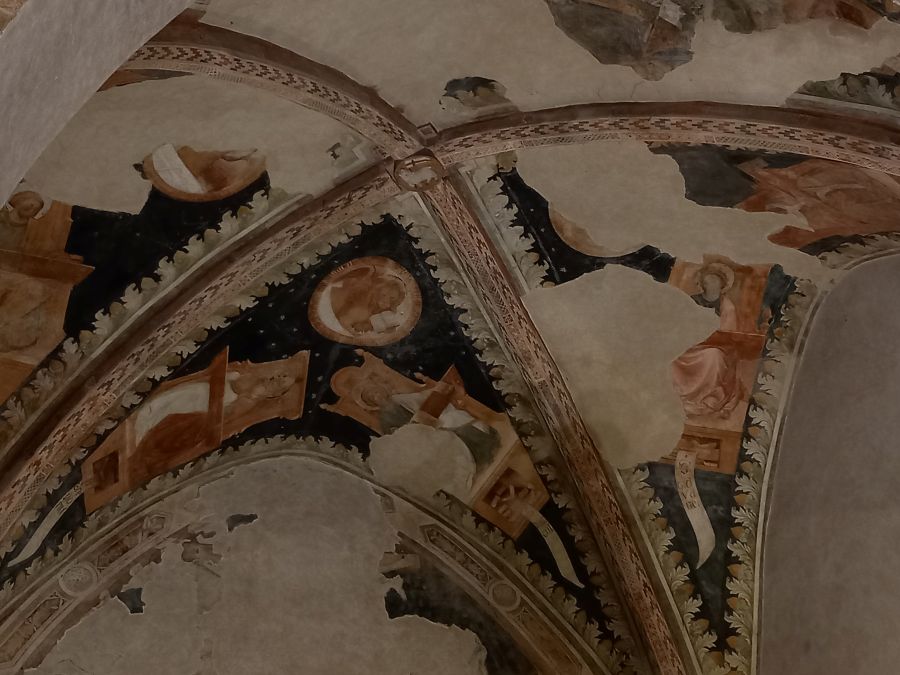- How to Tour Ravenna’s three Byzantine periods Chronologically
- Observing the Contrast of Byzantine Istanbul and Ravenna
- Forgotten Byzantine gems in Ravenna
- Shipped Ancient Monuments in Ravenna from Istanbul
Many objects on display in churches in Ravenna came from Constantinople. To show the connection between these ancient cities, let’s consider some of these ancient monuments from Istanbul.
Crowned Mary of Santa Maria in Porto
When visiting Ravenna, I sensed that much came from Istanbul, but the hints were seldom and weak. I was looking for items from the East, and here is my summary of what I observed.
Ravenna is unlike Venice, where historians have documented well-known ancient monuments from Constantinople. Yet, the Venetians took one item of interest that ended up in Ravenna.

In the 16th century, Santa Maria in Porto, the Greek Madonna, came from Constantinople. This ancient monument is a marble carving displayed in the Santa Maria in Porto church. How it came to Ravenna most likely was part of the load that the Venetians carried out of the city at the end of the 11th or the beginning of the 12th century. During those days, the Byzantine Empire and the Venetians had cross purposes.[1]https://www.thebyzantinelegacy.com/venice Much mystery surrounds this icon, and the local Catholics still venerate the statue. Picture[2]Greek Madonna (sculpture). (2024, June 20). In Wikipedia. https://en.wikipedia.org/wiki/Greek_Madonna_(sculpture
Marble and Patterns
In Ravenna, we are not looking for ancient monuments but mainly material and patterns from Istanbul.
The Byzantine Legacy says, “It is clear that the design and decoration of San Vitale was directly influenced by the latest trends in Constantinople. It is extensively decorated with marble from Proconnesius, an island in the vicinity of Constantinople, and reflects Constantinopolitan designs also found in Sergius and Bacchus. San Vitale also has split-palmette capitals that first were used in the Church of St. Polyeuktos in Constantinople built a short time earlier.”[3]https://www.thebyzantinelegacy.com/san-vitale
In light of this fact, how many capitals and marble ambos of these Ravenna basilicas came from the Constantinople region? The white-grey marbles dominated both locations, and Ravenna was imported heavily from the Asia Minor area, especially during the 5th and 6th centuries. One study of late antiquity imports just south of Ravenna in Classe states that “The results show the prevalence of Eastern imports. Almost 64.3% of the stone materials came from ancient Asia Minor (Turkey) or from the island of Proconnesos (Marmara Adasi).”[4]Late Antique marble trade: new insights obtained from stone artefacts from the San Severo complex (Ravenna, Italy) by HELENA TUMOVA , ANDREA AUGENTI , ANETA KUCHAROVA , ENRICO CIRELLI & RICHARD … Continue reading Based on this study and especially the type of marble with pure grains, the majority of marble found in these basilicas can be assumed to come from the Asia Minor (modern Turkiye) region.

The marble from Proconnesos produced these marble slabs that provoked the imagination—the Proconnesian marble from the island of Marmara, near ancient Constantinople.[5]see https://www.pallasweb.com/deesis/hagia-sophia-the-marble-revetment-25-images.html
The basket-shaped capitals are found in Hagia Sophia and the former Polyeuktos and Beyazit churches. They were most likely shaped in Asia Minor, or stonemasons came from there to work on the basilica.

Fresco Patterns
We do not know the extent of early mosaics in the early Constantinople churches. The Iconoclasm of the 8th and 9th centuries strongly influences that city. What remains today mainly is the post-iconoclasm result. In this way, the Ravenna mosaics show what some Istanbul churches looked like until the 7th century. One thing that I noticed was the fresco patterns that seem to match between the two cities. The frescoes in Spirito Santo and San Giovanni Evangelista (below) resemble many in the former Chora church of Istanbul. This could be said on the patterns found in the mosaics also.

I also became fascinated with the many pulpits in Ravenna, which I will write about in the coming days. Yet, the write-up about the St. John and St. Paul’s Church ambo gives a hint to what often happened: “The ambo of the cathedral came to Ravenna from Constantinople already finished; …[this] ambo was worked by artisans of Ravenna who took inspiration from that of the cathedral.”[6] write up found in the Archiepiscopal Museum in Ravenna How much of the Ravenna marble had already been carved, and did artisans in the city gain inspiration to replicate panels and capitals?
Check out my other explorations:
References
| ↑1 | https://www.thebyzantinelegacy.com/venice |
|---|---|
| ↑2 | Greek Madonna (sculpture). (2024, June 20). In Wikipedia. https://en.wikipedia.org/wiki/Greek_Madonna_(sculpture |
| ↑3 | https://www.thebyzantinelegacy.com/san-vitale |
| ↑4 | Late Antique marble trade: new insights obtained from stone artefacts from the San Severo complex (Ravenna, Italy) by HELENA TUMOVA , ANDREA AUGENTI , ANETA KUCHAROVA , ENRICO CIRELLI & RICHARD PRIKRYL |
| ↑5 | see https://www.pallasweb.com/deesis/hagia-sophia-the-marble-revetment-25-images.html |
| ↑6 | write up found in the Archiepiscopal Museum in Ravenna |

Leave a Reply